by Terry Messman
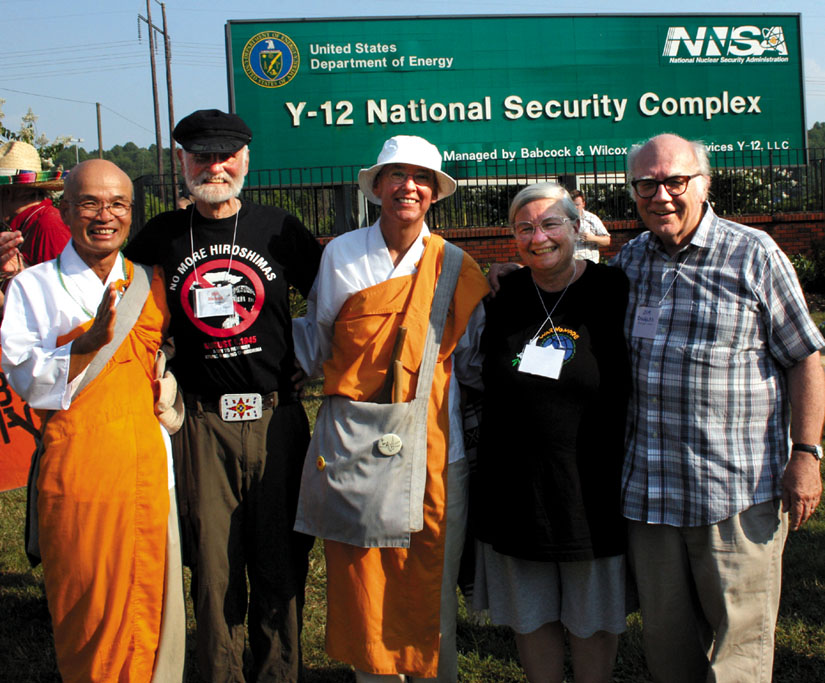
Protest Oak Ridge, Tennessee, 2015; left to right: Br. Utsumi Shonin, Father Bill Bichsel, Sr. Denise Laffin, Shelley Douglass and Jim Douglass; courtesy thestreetspirit.org
One Trident submarine can destroy a country. A fleet of Trident submarines is capable of destroying the world. Jim Douglass explains how Ground Zero Center organized a visionary campaign of nonviolent resistance to confront “the Auschwitz of Puget Sound.”
Street Spirit: While you were a professor of religion at the University of Hawaii in the late 1960s, you became active in the movement to end the Vietnam War. What led you to become involved in antiwar resistance while teaching in Hawaii?
James Douglass: Before living in Hawaii, I lived in British Columbia in Canada for two years, writing my book The Nonviolent Cross. So I was out of it in terms of resistance in the United States since I wasn’t living there. Going to Hawaii meant beginning to teach in a context which was also the R&R center for the military in the Vietnam War.
Read the rest of this article »
by Vinay Lal
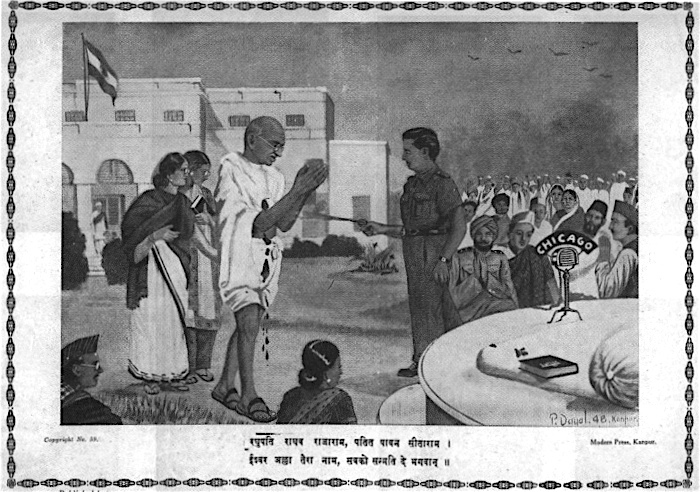
Popular Hindi press representation of Gandhi’s assassination; courtesy Vinay Lal collection
As India marked the 60th anniversary [2008] of Gandhi’s death, the tired old question of Gandhi’s “relevance” was rehearsed in the press. Once past the common rituals, we heard that the spiral of violence in which much of the world seems to be caught demonstrates Gandhi’s continuing relevance. Barack Obama’s ascendancy to the Presidency of the United States furnishes one of the latest iterations of the globalizing tendencies of the Gandhian narrative. Unlike his predecessor, who flaunted his disdain for reading, Obama is said to have a passion for books; and Gandhi’s autobiography has been described as occupying a prominent place in the reading that has shaped the country’s first African American President. Obama gravitated from “Change We Can Believe In” to “Change We Need”, but in either case the slogan is reminiscent of the saying to which Gandhi’s name is firmly, indeed irrevocably, attached: “We Must Become the Change We Want To See In the World.” Obama’s Nobel Prize Lecture twice invoked Gandhi, if only to rehearse some familiar clichés – among them, the argument, which has seldom been scrutinized, so infallible it seems, that Gandhian nonviolence only succeeded because his foes were the gentlemanly English rather than Nazi brutes or Stalinist thugs.
Read the rest of this article »
by Vinay Lal
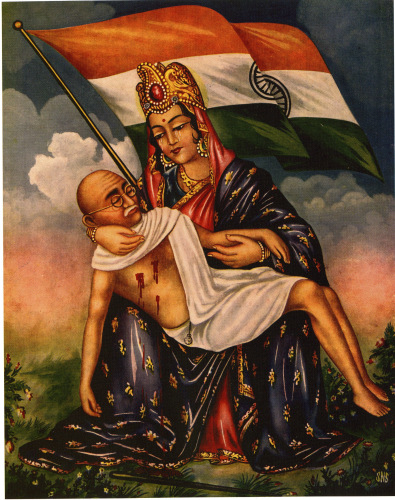
Indian folk art representation of Gandhi’s assassination; courtesy Vinay Lal collection
Uniquely among the major public figures of the modern world, Mohandas Gandhi attracted an extraordinarily wide and diverse following and, perhaps oddly for someone who is customarily thought of in terms of veneration, an equally if not more diverse array of often relentlessly hostile critics. (1) The first part of this story is better known than the latter part of the narrative around which this paper is framed, (2) though much remains to be understood about the manner in which Gandhi, notwithstanding his rather strident views on modernity, industrial civilisation, materialism, sexual relations, indeed on everything that is ordinarily encompassed under the rubric of social and political life, drew to himself people from very different walks of life.
Among his most intimate disciples, who, it is no exaggeration to say, surrendered their life to the Mahatma, one thinks of the daughter of an English admiral, raised on the music of Beethoven in the lap of luxury and immense privilege; a Tamil Christian, trained as an accountant and economist, who was among the first Indians to earn a degree in business administration; a Gujarati villager, son of a schoolteacher, who was embraced by Gandhi when they first met in 1917 as something like a long-lost son; and an Anglican clergyman, arriving in India from Britain on what was destined to become a one-way ticket, who came to the realization that Gandhi was a better Christian than many who call themselves Christians. (3)
Read the rest of this article »
by Asha Devi Aryanayakam
Editor’s Preface: This article is taken from The War Resister, issue 92, Third Quarter 1961. We have posted a number of other articles on Shanti Sena, which may be accessed via our search function. Notes about the author, references, and acknowledgments are found at the end. JG
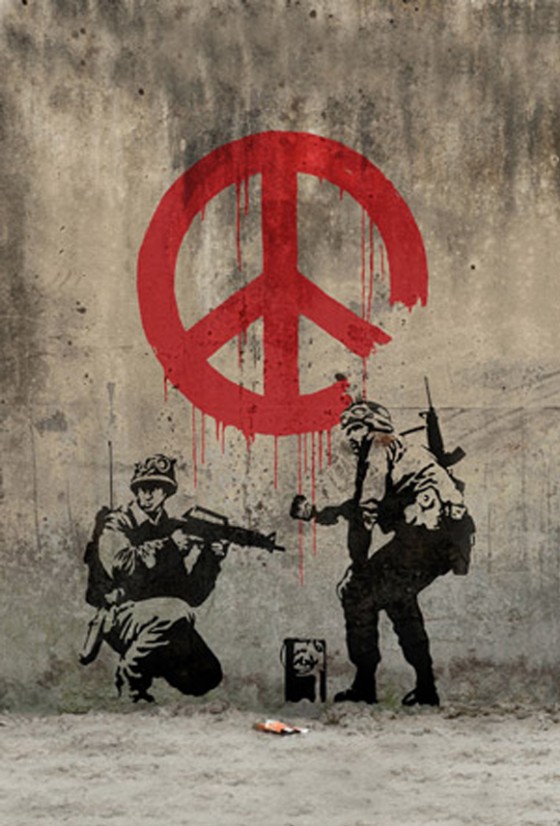
“Soldiers Painting Peace”; mural by Banksy; courtesy stencilrevolution.com
The conception of a Peace Brigade or a Peace Army was first placed before the Indian people by Gandhi in 1938. He was then engaged in the great experiment of reconstructing Indian national life through nonviolence. The movement for political independence was only a part of the story. The monster of communal tension had just begun to rear its ugly head and the Peace Army was Gandhi’s answer to the problem. With his characteristic straightforwardness, he placed his proposal in down-to-earth practical terms without any philosophical introduction.
As he wrote, ‘Some time ago I suggested the formation of a Peace Brigade (Shanti Sena), whose members would risk their lives in dealing with riots, especially communal. The idea was that this brigade should substitute for the police and even the military. This sounds ambitious. The achievement may prove impossible.’
Gandhi then suggested qualifications for the volunteers, which are mentioned by Donald Groom in his contribution to this issue of the War Resister [posted below under this date]. As Gandhi wrote, ‘Let no one understand from the foregoing that a nonviolent army is open only to those who strictly enforce in their lives all the implications of nonviolence. It is open to all those who accept the implications and make an ever increasing endeavour to observe them. There never will be an army of perfectly nonviolent people. It will be formed of those who will honestly endeavour to observe nonviolence.’ (Harijan, 21.7.1940.)
Read the rest of this article »
by Donald G. Groom
Editor’s Preface: This article is taken from The War Resister, issue 92, Third Quarter 1961. We have posted a number of other articles on Shanti Sena, which may be accessed via our search function. Notes about the author, references, and acknowledgments are found at the end. JG
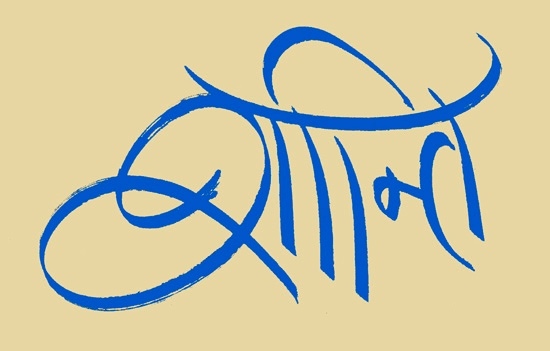
“Shanti/Peace” in Sanskrit; courtesy palmstone.com
In my view there are two main aspects of the World Peace Brigade, that of individual and group action carrying out service or direct peace action; the other the supporting action of thousands and millions who have heartfelt sympathy with its purposes. All will have faith in the revolutionary power of love and compassion in all spheres of human activity and in the innate goodness of man, even though the upholding of this faith may involve suffering and death. But those people who are chosen for direct involvement in the problems of human suffering, tension, fear and all forms of violence would have to function at a different level and demonstrate the power of nonviolence for peacemaking which could only come through a high quality of life and discipline. What is expected therefore from such volunteers?
Read the rest of this article »
by Prof. Giovanni Pioli
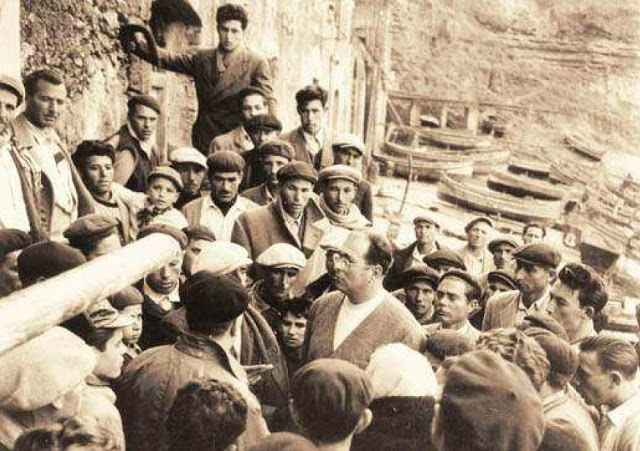
Dolci organzing the fishermen of Trappeto, 1952; courtesy en.wikipedia.org
Editor’s Preface: This article continues our series of historically important articles from the War Resisters’ International archive, our goal to trace the influence of Gandhian nonviolence on the early pacifist movements. This is from The War Resister, issue 71, Second Quarter 1956. We have previously published articles by or about Dolci, one of the great exponents of Gandhi’s constructive program. These may be accessed via our search box. Please consult the notes at the end for further information. JG
Pamphlets, bulletins and books have now been written by Danilo Dolci and the valiant men and women who join him for a time to share his experience, his poverty, his distress and his hard labour for the uplift of those submerged, demoralised ‘criminal’ masses who struggle — even beyond legal limits — for the bare necessities of life. Italian social workers, pacifists, and humanitarians respect this literature, dealing with conditions in Trappeto and Partinico, situated in the Province of Palermo, Sicily — infamous as a centre of Sicilian banditry and the mafia.
Read the rest of this article »
by H. Runham Brown
Editor’s Preface: H. Runham Brown was a British anarchist and secretary of War Resisters’ International. He was appointed in 1931, soon after being released from prison, having served two years for conscientious objection. He authored books about peace and the Spanish civil war, and Hitler’s rise. This article is taken from The War Resister: Quarterly News Sheet of the War Resisters’ International, issue XXXI, Summer 1932. Please also see the archive reference information and acknowledgments at the end. JG
Few people in the West can understand why a man should go on a hunger strike. It appears to them that he is only hurting himself and they would rather hurt somebody else. We do not here ask that so strange an action should be understood, but that a fact should be taken notice of. From time to time a man in prison refuses to take food until his objective has been attained. He is forcing the issue. Such action may be wise or foolish; it depends on the man.
Read the rest of this article »
by A. Fenner Brockway
Editor’s Preface: Brockway’s short article appeared in The War Resister: Quarterly News Sheet of the War Resisters’ International, issue XXVII, Winter 1930-1931. It is another in our series tracing Gandhi’s impact on European and American individuals and movements, and is also another posting in our WRI project category, accessible at this link. Please also consult the notes at the end for biographical information about Brockway, archive reference, and acknowledgements. JG
The method of nonviolence as a positive instrument for securing freedom and justice is being employed in India on a scale never before attempted in human history. The development and results of the Nationalist struggle will be of greatest importance to the future of our movement as a practical contribution to the solution of the world’s problems.
The Indian people have adopted the method of nonviolence for two reasons. With Mr. Gandhi and his immediate followers it has been a matter of principle. Mr. Gandhi sees brute force as the instrument of tyranny and its mentality as the philosophy of tyranny; he cannot therefore adopt it as the instrument and philosophy of freedom. But with many of Mr. Gandhi’s colleagues, nonviolence has been a matter of expediency. The Indian people are unarmed; the British have guns and armoured cars and bombing aeroplanes. Under such conditions the method of force would be suicidal.
Read the rest of this article »
by Vladimir Tchertkoff
Editor’s Preface: The prominent religious figure Vladimir Tchertkoff was Tolstoy’s editor in the latter part of Tolstoy’s life. This letter, dated 9 March 1931 is taken from The War Resister: Quarterly News Sheet of the War Resisters’ International, issue XXIX, Summer 1931, and is another in our WRI project. We have also previously posted several articles by Tchertkoff, including unpublished correspondence with Gandhi and a previously unpublished Tolstoy translation. Please consult the Editor’s Note at the end for further biographical information and links. Tchertkoff’s other articles may be accessed via our WRI Project category. JG
Dear Mahatma Gandhi,
Allow me, on behalf of myself and our Moscow friends, to express our deep and heartfelt joy at your liberation from prison. We earnestly desire for you the necessary strength to continue your righteous and great work. May God help India to attain as quickly as possible that emancipation from foreign dominance that she so fervently desires. We yet more desire for you and ourselves the emancipation of everyone, not only from foreign oppression, but particularly from all servitude of man to man, even though it be within the limit of one and the same race; and especially from the last remnants of that superstition that one can [anymore] protect any righteous cause by force of arms or military preparations.
Read the rest of this article »
by Mohandas Gandhi
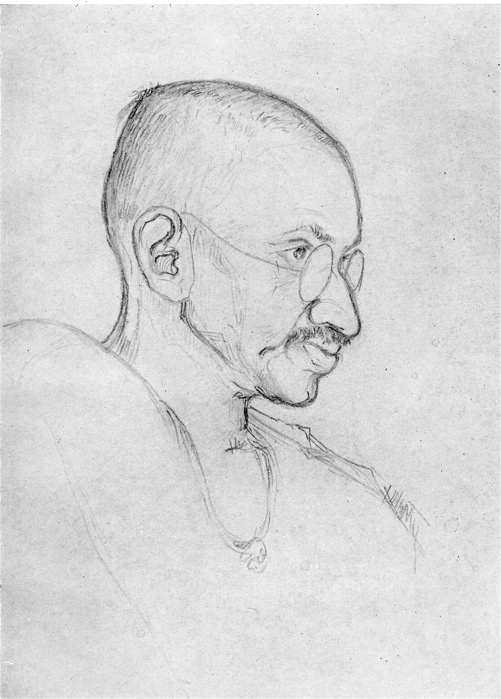
Pencil drawing of Gandhi, 1931, by Kanu Desai; courtesy Golden Vista Press
Editor’s Preface: This article, another in our WRI project, is from The War Resister: Quarterly News Sheet of the War Resisters’ International, issue XXVII, Winter 1930-1931. Pre-World War II, European pacifists were slow to come under the influence of Gandhi. They had disavowed violence in all its forms, but were not always sure that Gandhian satyagraha was an equal commitment. WRI consistently supported Indian independence and self-rule, and about this aspect of Gandhism there was no ambivalence. Please also see the archive reference information and acknowledgments at the end. JG
Here in Gujarat well tried and popular public servants have been arrested one after another, and yet the people have been perfectly nonviolent. They have refused to give way to panic, and have celebrated the arrests, by offering civil disobedience in ever-increasing numbers. This is just as it should be.
If the struggle so auspiciously begun is continued in the same spirit of nonviolence to the end, not only shall we see Purna Swaraj [complete independence] in our country before long, but we shall also have given the world an object lesson worthy of India and her glorious past.
Swaraj [self-rule] won without sacrifice cannot last long. I would therefore like our people to get ready to make the highest sacrifice they are capable of. In true sacrifice all the suffering is on one side; one is required to master the art of getting killed without killing, of gaining life by losing it. May India live up to this mantra . . .
Read the rest of this article »











